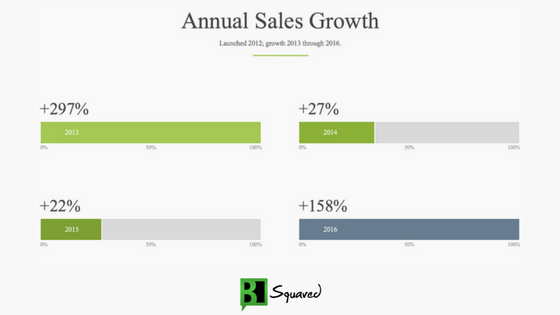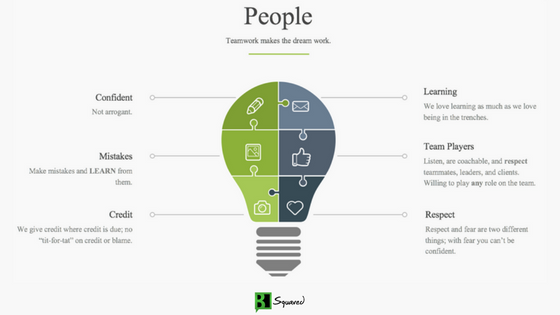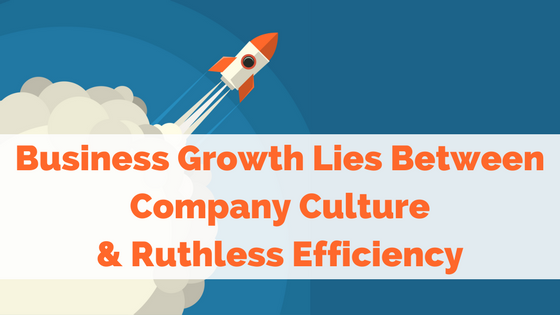— October 25, 2017
Statistically speaking, business growth should be eluding me.
More than 50% of business owners survive only five years.
And If I want to make it to 10 years? My chances of failing are much greater.
As we round out B Squared’s fifth year in business, we look at what it took to get here and what it will take for business growth to get to year 10 and beyond.
Past Business Growth
B Squared Media launched in 2012 after a year or so of moonlighting.
It’s the third company I’ve owned and the only one that’s made it to five years in business.
Our first year I had two clients. Two!
This year, we have over 20 clients and growing team of freelancers.
Furthermore, I’ve had two hyper-growth years with triple-digit growth and have seen at least 20% growth in the “down” years.

I wouldn’t say we’re “killing it” but I do realize that many small businesses would love to be in our shoes.
(October 27, 2017), I spoke at Sprout Social’s Partner Day event about scaling and growth (look for conversation surrounding the hashtag #SproutPartnerDay, if interested!).
Everyone wants to know what my “secret” is. I don’t keep secrets. Not in business, anyway!
So I’m going to tell you straight up what it takes to make it to year five and continue to see business growth.
Ruthless Efficiency
Business growth is great and all, but at the end of the day it’s about revenue.
For me personally — and since I am the entire Sales Department — this means my sales efforts and closing ratio take top priority.
We recently saw what not being focused on sales did to the business … and it wasn’t pretty!
As soon as I got back to doing what I do best (sales), I was able to cram our pipeline with enough leads that we’re on a hiring frenzy again.
Being ruthlessly efficient will help you with business growth because you’re playing to everyone’s strong suits and also giving them the tools necessary to continue to thrive in an ever-changing environment.
Business Growth With The 4 P Method
When it comes to ruthless efficiency, here are the four areas (or four Ps) we concentrate on.

1) Planning
There are four major areas in planning we focus on for business growth.
- Your Network: Yes, we plan for leveraging our network, too! This means researching who is important to connect with, from influencers to potential clients, to coming up with a clever way to interact, engage, and hopefully convert this person to a connection.
- Business Strategy: Including your overarching strategies for your business, your growth plan, your financial plan, your supply/demand planning, etc.
- Tactical Planning: Here’s where you get to the nitty-gritty. Document your plans for marketing, services/products, finances (especially goal setting).
- Organizational Management: How will you organize ALL of your resources in a way that leads to growth/scale?
2) Processes
Processes, or workflows as they’re often called, are essential to ruthless efficiency because they help you free up time.
When you’re not wasting time on recreating the wheel, you’re able to focus more on the next big iteration for making your process even better and more efficient.
Helpful hint: Good processes or workflow are transferrable and repeatable!
3) People — we’ll get to this in the next sections!
4) Pace
Managing the hyper-growth we had in 2013 and 2015 made me realize that we were missing a P.
I added PACE to set goals and benchmarking to grow steadily versus wildly (trust me, everyone thinks they want hyper-growth but it’s an organizational nightmare!).
We break PACE down into four groups:
- Current goal
- 1-year goal or “by the end of this year/next year I want …”
- 3,4,5+ year goals. This is where we start to identify what revenue streams make the most sense/money.
- Lifetime goal or “end game” (Are you in it for the long haul or to sell?)
Company Culture Is Key For Business Growth
People are an important P for ruthless efficiency, AND they’re critical when it comes to company culture.
When we hit our hyper growth spurt in 2013, I was no longer “enough.” We had to hire.
I’ll admit that management of people is not my strong suit.
I’m too trusting; I assume you’re going to do what you say you’re going to do.
Which has led to:
- Missed deadlines
- Lying (to me, clients, and team members)
- Over-deligating to subordinates
- Stealing from the company
- A shakedown for unearned wages/commissions; false claims
- Loss of clients
Ouch, right?
I may not like managing people but you can see where letting leadership and management fall by the wayside can get you into serious trouble.
How To Hire
Now when we’re looking to add to the team we use extreme caution and embody a “hire slow, fire fast” mentality.

Here are the key traits we look for in the freelancers we do hire:
- Confident, but not arrogant.
- Makes mistakes (duh, we’re human!) but learns from them quickly.
- Gives credit where credit is due; doesn’t play the blame game.
- Loves learning just as much as being in the trenches.
- Listens; is coachable, and RESPECTS team members, leaders, and clients.
- Willing to play ANY role on the team.
A note on respect. Respect and fear are two different things.
You cannot fear team members, leaders, or clients and be confident.
As a leader, you need to recognize the difference and hire/fire based on those distinct differences.
Repeat after me: YOU CAN’T DO EPIC SHIT WITH BASIC PEOPLE.
Other People Problems
When your team is made up of freelancers or you’re part of a remote team (we’re both of these things), you have to go the extra mile.
Here are a few things to think about.
1) Flexibility
With freelancers or a remote team, hours are going to vary person-to-person.
Get clear on available hours, key client deadlines, and ways in which you’ll keep your team up-to-date.
Then, use tools like Basecamp or HubStaff to keep track of task and time management.
2) Communication
First of all, there are a million tools that make communication a breeze, even if it’s not face-to-face.
Whether you use the aforementioned Basecamp, Slack, or some other tool, we think it’s wise to incorporate video calls every so often.
Once a month, we have our Monday Meeting (called the Level 10) with video on so we can feel more connected as a team.
3) File Sharing & Organization
If you do lead a team of freelancers or manage a remote team, you’ll want to get clear on how you will share (or not share) certain information and files with your team.
Dropbox for Business allows us to seamlessly share (or unshare) files and folders with team members. Same with Basecamp.
Most noteworthy, all of the above items need to be accounted for when PLANNING, specifically when looking at Organizational Management.
Business Growth = Company Culture + Ruthless Efficiency
Whether you’re just starting out or entering year six in business — like we are — you need to carefully consider the 4 Ps.
Finally, there is no “secret sauce” when it comes to growing and scaling your business.
I suppose if I had to consolidate all of the advice here into one statement, it would be: DOCUMENT EVERYTHING!
However, we all know a written plan and implementation of that plan are two totally different things.
How do you plan for business growth at your company? Care to share? Give us a shout in the comments section below!
Business & Finance Articles on Business 2 Community
(105)






